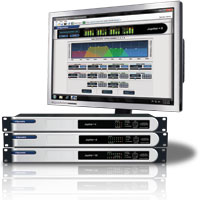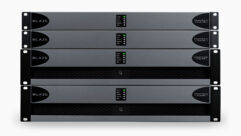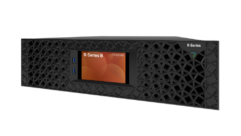

Symetrix Jupiter 8 Review
Sep 13, 2010 12:00 PM,
By John McJunkin
Simple app-style control from an intelligent processor.
There’s nothing new about the notion of controlling a hardware engine with a software front-end interface. It’s an idea that is now being exploited at every turn—and rightfully so. Controlling hardware from a flexible, user-definable interface is a powerful and easily understood way of doing things, which may be important if volunteers or other untrained users will be working with a system. A newer, more up-to-date twist is now being incorporated into the software-controlled hardware paradigm—a twist that was suggested by the introduction of apps for smartphones.
Today’s smartphones are computers, for all practical intents and purposes, and the apps developed for them range from very simple processes to highly sophisticated programs. Either way, the owner of the phone can download and use apps intended for an incredibly vast diversity of purposes, including reading novels, locating via GPS, and multitrack digital recording. Symetrix has introduced its Jupiter digital signal processor/routing system, which leverages the notion of apps as used with smartphones. Jupiter’s diversity of purposes is not as wide as that of smartphones, but it is broader than that of most other hardware platforms.
Specifically, the Jupiter serves in four different domains: mixing and routing, public address and distribution, sound reinforcement, and special purpose signal processing. I spent time with a Jupiter 8 and found that the app model translates into these domains nicely.
Symetrix’ Jupiter 8 is the mid-line model in a line of three new processors, including the Jupiter 4 and Jupiter 12. Because of the software-front-end-controlling-hardware-engine topology, the physical unit is just about as simple as it gets, and I really like that way of thinking—not to mention the handsome hardware unit. It’s a 1RU processor with only display LEDs and a network connector on the front panel, and a rear panel populated with a power inlet, network connectors, analog I/O, logic outputs, and external control inputs. The audio, logic, and control connections are all Euro-style 3.81mm terminal blocks. This is the beauty of relegating all the control to a software front end: The apps grant the user all the necessary control over the system, so virtually no front-panel controls are necessary on the hardware. Symetrix does make proprietary hardware controls available for in-wall mounting, including the ARC-2 wall panel and the RC-3 potentiometer. Switches and logic outputs can also be connected to the unit. The point of these remote controls is to facilitate basic control over the system by end-users in remote locations. In particular, the ARC-2 is quite sophisticated, with the capacity for preprogramming with up to 24 menus through which the end-user can navigate to gain control of the system. I was not shipped any of these controllers, but I have had experience with them using other Symetrix systems.
In Symetrix’ vernacular, the first of the four types of apps available is “mixing and routing.” These apps include signal routing and automixing type configurations for houses of worship, courtrooms, and banquet rooms—which seems pretty basic, but the automixing capacity of the system can get quite sophisticated. The second type of app is “public address and distribution,” intended for distributed speaker systems such as in public transit stations, theaters, and shopping malls. Here, signal distribution is a key function, but ducking signals for the benefit of public announcements is also important. Symetrix’ third type of app is used in the domain of sound reinforcement, intended for applications in nightclubs, courtrooms, and lecture halls. The main focus of this type of app is loudspeaker management signal processing, along with signal routing. The fourth and final Symetrix app category is “special purpose signal processing,” intended for broadcast facilities, production suites, and live sound. This would include signal routing between broadcast studios, mastering-type processing to polish broadcast signals, and similar EQ and dynamics processing for live sound.
Symetrix Jupiter 8 Review
Sep 13, 2010 12:00 PM,
By John McJunkin
Simple app-style control from an intelligent processor.
I easily connected the Jupiter 8 hardware unit to my computer via Cat-5 Ethernet cable, and used a connection wizard within the computer software to establish a network connection between computer and hardware unit. Once the connection was established, I was able to choose an app to determine the way the hardware is used. Among the broad categories of apps mentioned prior, there are gain-sharing automixers, gating automixers, line and mic processors, numerous sound-reinforcement configurations, a stereo mixer, and a transit SPL app, which is intended for use in public transportation hubs for public address and background music.
As an example, the first of the Jupiter 8 system’s gain-sharing automixers offers eight inputs and eight outputs. (The model number of each system indicates the number of available inputs; the Jupiter 4 and Jupiter 12 each have four outputs, while the Jupiter 8 has eight.) The automixer app presents four stages of signal processing in sequence on the input channels: British EQ, an expander, a dynamics section, and a feedback fighter (a sophisticated 16 filter scheme). Each input also provides controls for phantom power, polarity inversion, and a noise and tone generator. The gain-sharing automixer component comes next in the signal flow, followed by an 8×8 matrix mixer. Each output channel features a 15-band graphic EQ, a speaker manager module (with eight bands of parametric EQ, HPF, LPF, and a delay), a compressor, and a limiter. This processing sounds excellent and offers a huge amount of control over signal flow and behavior.
Related Links

Broadcast Pix iPixPanel Review
Broadcast Pix sells video production switchers that, on the surface anyway, can look similar to traditional switchers. Specifically, many Broadcast Pix configurations use standard-layout 1M/E or 2M/E control panels…

Traditionally, one of the most vulnerable points in any sound system has been the power amplifier. Operating at high temperatures for long periods, the power amp has always been a target for shorts and overloads, but the technology advances in the past few years have met the challenge and created a new breed of power amps offering a greater degree of local and remote control…

There was a time when setting up AV control systems was considered to be sort of a black art reserved only for seasoned techies who never revealed their trade secrets. Since those days, the realm of AV control has become much more open…
Another example of a typical app is Sound Reinforcement #6, which offers an HPF, an LPF, a 15-band graphic EQ, a two-band compressor, and a feedback fighter on each of the eight input channels. The input signals are mixed in an 8×8 matrix mixer, then passed along to the eight outputs, which each have a speaker manager module, gain stage, and limiter. Other signal processing is available as well, including three- and eight-band parametric EQ; an AGC; a two-stage series dynamics processor; a FIR filter; two-, three-, and four-way crossovers; a stereo distributor; ducking priority mixers; and an SPL computer (which incorporates ambient sensing microphones to determine levels). There is a huge amount of available DSP here, and as more apps are developed, more of it will be leveraged in creative and powerful ways.
Bottom line here, the Symetrix Jupiter series processors cleverly use the app convention, borrowed from smartphone technology, to facilitate quick and easy configuration of the hardware processor to accomplish a broad range of tasks. It’s quite easy to use as a result, and the processing sounds great—no surprise coming from Symetrix. This marks a new way of thinking, and I predict that numerous manufacturers will adopt this model. Frankly, it’s very smart on the part of Symetrix, because it makes the Jupiter system incredibly versatile and useful in a lot of distinct applications. I recommend taking a look at it.
John McJunkin is the principal of Avalon Podcasting in Chandler, Ariz. He has consulted in the development of studios and installations, and he provides high-quality podcast-production services.
Product Summary
- Company: Symetrix
www.symetrixaudio.com - Product: Jupiter 8
- Pros: Powerful routing and processing capabilities.
- Cons: Software not available for Mac.
- Applications: Any application that requires signal routing and processing under remote control.
- Price: $1,239 (Jupiter 4); $1,449 (Jupiter 8); $1,649 (Jupiter 12)
Specifications
- Inputs
- Nominal input level: +4dBu line or -36dBu mic level with 20dB of headroom
- Mic preamp gain: +40dB.
- Input trim: ±24dB.
- Maximum input level: +23dBu.
- Input impedance: >18kÙ balanced, >9kÙ unbalanced, >2kÙ w/20V PP
- CMRR: >50dB @ 1kHz, unity gain
- Mic preamp EIN: >-125dBu, 22Hz -22kHz, 100Ù source impedance
- Phantom power: +20VDC, 20mA maximum per input
- Nominal output level: +4dBu line level with 20dB of headroom (unbalanced configuration yields 6dB
- Maximum output level: +24dBu
- Output impedance: 200Ù balanced, 100Ù unbalanced
- Sample rate: 48kHz
- Frequency response: 20Hz-20kHz, ±0.5dB
- Dynamic range: >110dB (A-weighted), input to output
- THD+ noise: <-85dB (un-weighted), 1kHz @ +22dBu with 0dB gain
- Interchannel crosstalk: <-90dB @ 1kHz, typical
- Latency: <1.6ms, input to output with all DSP inactive
Outputs
lower output level)
System










